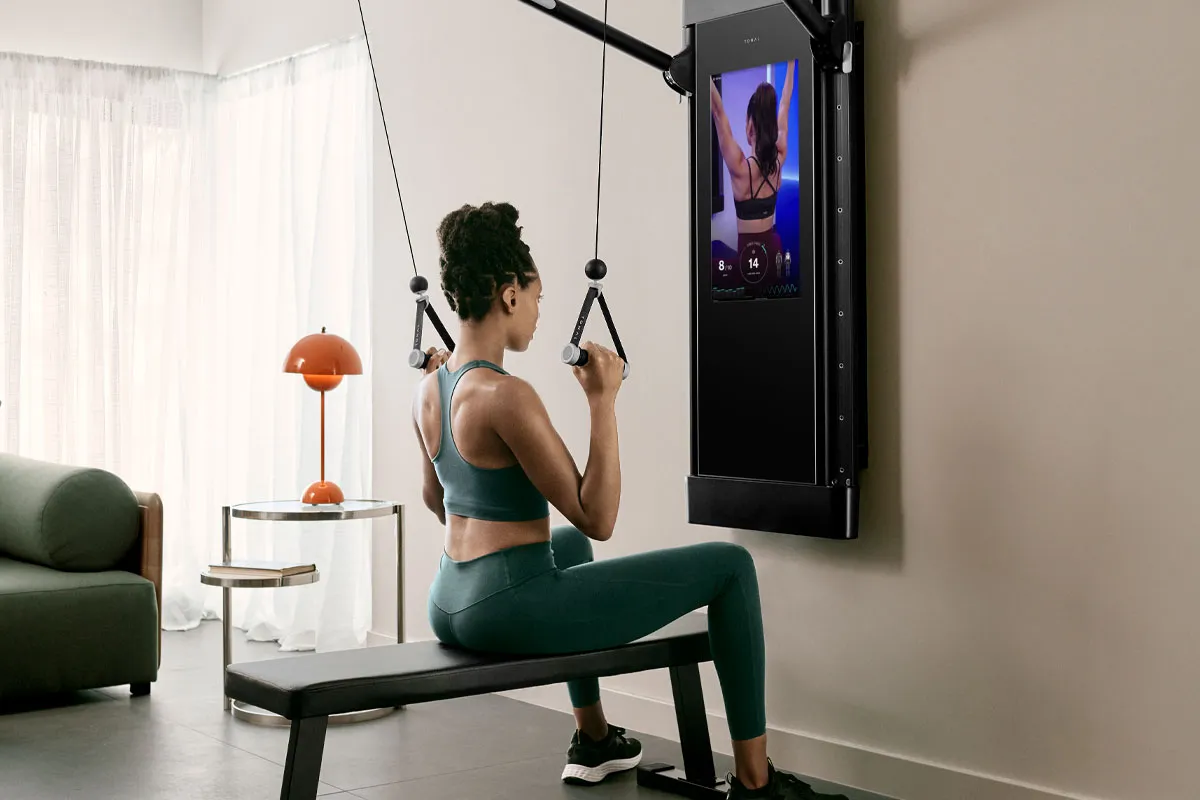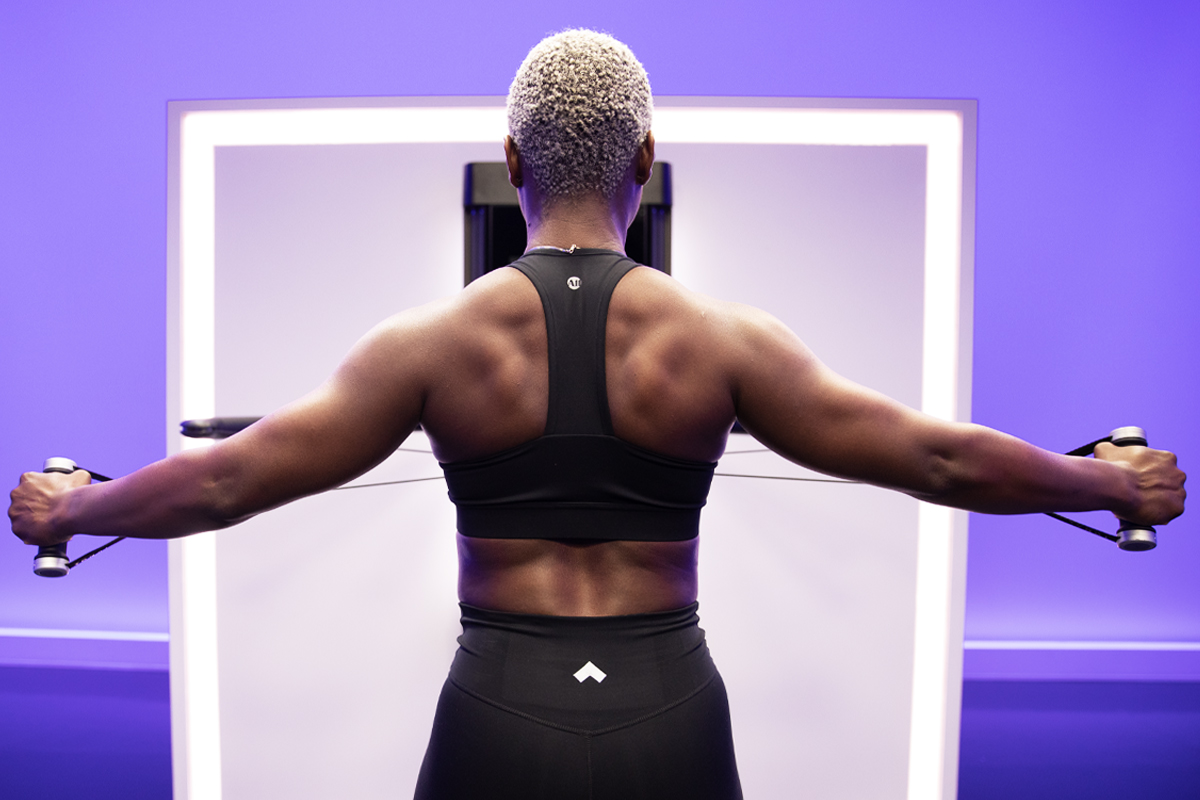Here’s why these moves are key to building overall strength and making big gains.

When it comes to strength training, it’s easy to focus on “mirror muscles,” the ones we can see in our own reflections. But it’s essential to also train the muscles you can’t see like the ones along your back if you’re serious about building well-rounded strength.
“People love doing chest day, and that’s great, but you have to be equally attentive to the backside of your upper body to maintain muscular balance,” says Jenna Moore, a certified strength and conditioning coach and Programming Specialist at Tonal. “That’s going to play a role in your overall posture and your overall strength.”
One way to do that: adding vertical pull exercises, which work your major back muscles, to your weekly routine. Here’s everything you need to know about vertical pull exercises and how to put them to use to unlock bigger back gains.
What Are Vertical Pull Exercises?
Moore defines a vertical pull exercise as any movement in which you’re pulling resistance in a vertical path from the overhead position. They’re usually done with your arms extended overhead as you pull weight up or down toward your chest using both the shoulder and elbow joints. Classic vertical pull exercise examples include lat pulldowns and pullups.
While the weight in a deadlift follows a similar movement pattern, Moore explains that the lower-body exercise is technically a hinge, not a vertical pull. What about biceps curls? While biceps curls are a pulling move, Moore says they don’t fit the definition because they only involve movement at one joint—the elbows—not the elbows and shoulders.
What Are the Benefits of Vertical Pull Exercises?
Vertical pull exercises primarily work the large muscles of the back—the latissimus dorsi (or lats) the trapezius (or traps)—so if you’re looking to build a stronger back, you should be regularly doing these moves.
Depending on the specific move, Moore says vertical pull exercises can also strengthen smaller muscles including the posterior deltoids (or the back of your shoulders), rhomboids, and biceps. “We always try to switch up the different types of variations we do so that we can target not only those bigger muscle groups but also some of those small, assistant muscle groups,” she says.
These exercises mirror activities you might do outside your workouts, such as climbing a ladder, pulling yourself up to clean the gutters on your roof, rock climbing, racing your kids across the monkey bars, or scaling a cargo net in an obstacle race. Building a strong upper body through vertical pull exercises will make those movements feel easier in your daily life.
How Often Should You Do Vertical Pull Exercises?
Vertical pull exercises are just one element of a well-rounded strength training routine, so you don’t need to spend hours on these movements to enjoy the benefits.
“The bare minimum is making sure that we’re working all of our major muscle groups at least twice a week,” says Moore. Your back muscles are also used in horizontal pulling exercises, such as rows, so if those are already included in your workouts, you may only need to add vertical pulling once a week.
For optimal strength and hypertrophy gains, Moore says to aim for 10 to 20 sets of back exercises (which can include horizontal and vertical pulling moves) each week. If you’re just getting started with resistance training, don’t stress if that seems like a lot. Start with just a couple of sets and gradually increase your volume over time.
Vertical Pull Exercises with No Equipment
Because you’re pulling weight down from overhead in vertical pull exercises, these moves are especially difficult to do with just your body weight or even with dumbbells. Try these exercises to work your back without added weight.
Pullup
Why it Works: Moore likes how the basic pullup is a very functional exercise that addresses both grip strength and your back muscles. She says pullups—and chinups, a variation in which you use an underhand grip for more biceps and chest engagement—are the “gold standard” for vertical pull exercises you can do with just your body weight.
How to Do it: Grip the bar with your palms facing away from you, hands slightly wider than shoulder-width apart. Engaging the muscles of your arms and back, bend your elbows and pull your body up until your chin is above the bar. Lower to the starting position and repeat.
Prone Lat Pulldown
Why it Works: If you don’t have access to a pullup bar, Moore recommends this bodyweight exercise that targets similar muscles without any equipment.
How to Do it: Lie face down on your mat. Lift your head and chest off the ground and extend your arms overhead. Bend your elbows, pulling them toward your torso, as you bring your shoulder blades together. Extend your arms and repeat. To make it more challenging, loop a resistance band around an anchor point directly in front of you just above floor level. Take one end of the band in each hand and pull it back toward your torso.
Vertical Pull Exercises on Tonal
Tonal’s adaptive digital weight makes it uniquely suited to performing vertical pull exercises at home. With Tonal’s adjustable arms, you can easily do a variety of moves that work your upper body through this movement pattern. Here are Moore’s top picks.
Neutral Lat Pulldown

Why it Works: The lat pulldown is a classic example of a vertical pull exercise that isolates the back muscles for strength gains.
How to Do it: Start with arms extended overhead, palms facing Tonal. Drive the elbows down toward the floor and pull the handles to the outside of your shoulders, rotating your hands to face your body. Control the weight back up to starting position, straightening the elbows.
Barbell Seated Lat Pulldown

Why it Works: Since you’re using the strength of both your arms and both sides of your back in this barbell variation, Moore says it’s an excellent option for loading up the resistance to build maximum strength in your back.
How to Do it: Facing Tonal, sit straddling the bench slightly behind the end of the arms and grip the bar slightly wider than shoulder width. Using your back, pull the bar toward your collar bones by bending your elbows and drawing them down like there are magnets on your elbow and rib cage. Let the weight back up with control, straightening at the elbows, and repeat.
Barbell Chinup
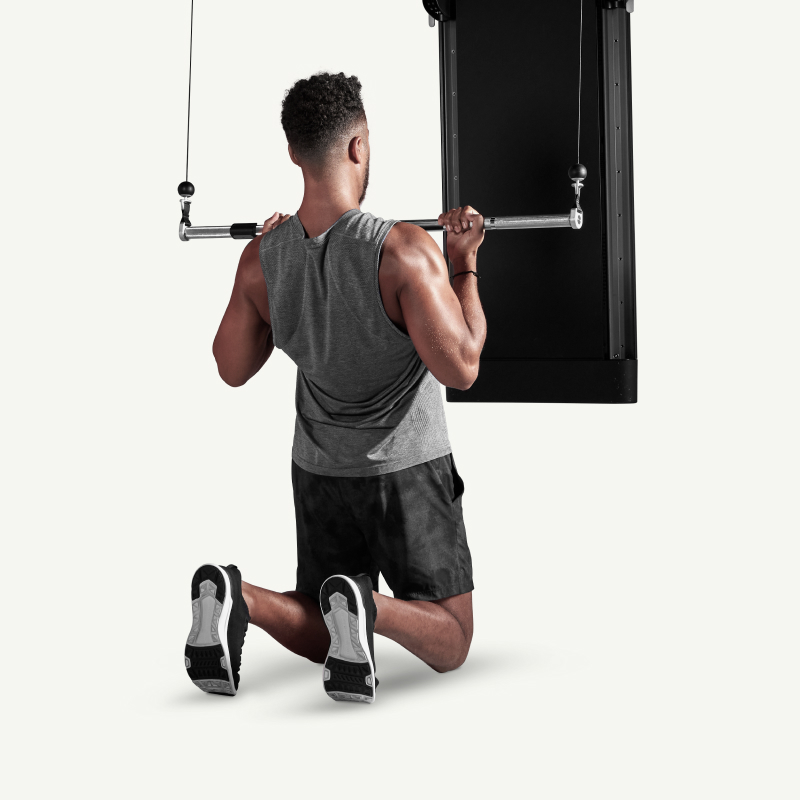
Why it Works: While the lat pulldown works the upper portion of your lats, Moore says this exercise puts the focus on your lower lats. “Because of your grip, you also get more biceps activation in a barbell chinup than in a regular lat pulldown,” she says.
How to Do it: Grip the bar shoulder-width apart with palms facing your body. Get into a tall kneeling position with your toes tucked on the floor. Using your back, pull the bar toward your collar bones by bending your elbows and drawing them down and back away from Tonal. Control the weight back up, straightening at the elbows, and repeat.
Alternating Neutral Lat Pulldown

Why it Works: “Alternating exercises are great for maintaining muscular balance,” says Moore. By addressing any strength imbalances in this single-sided exercise, you’ll ultimately be able to lift more in your standard lat pulldown.
How to Do it: Start with arms extended overhead, palms facing Tonal. Using your back, pull one handle to the outside of your shoulder, rotating it to face inward, and bend your elbow like there are magnets on your elbow and rib cage. Slowly control the weight back up and alternate sides.
Tonal Workouts with Vertical Pull Exercises
You’ll find vertical pull exercises in several coach-led workouts on Tonal because they’re so effective at strengthening the lats and traps. Moore recommends these programs that include vertical pull exercises as part of a full-body strength routine.
Mini Sets, Major Gains – Multiple Coaches
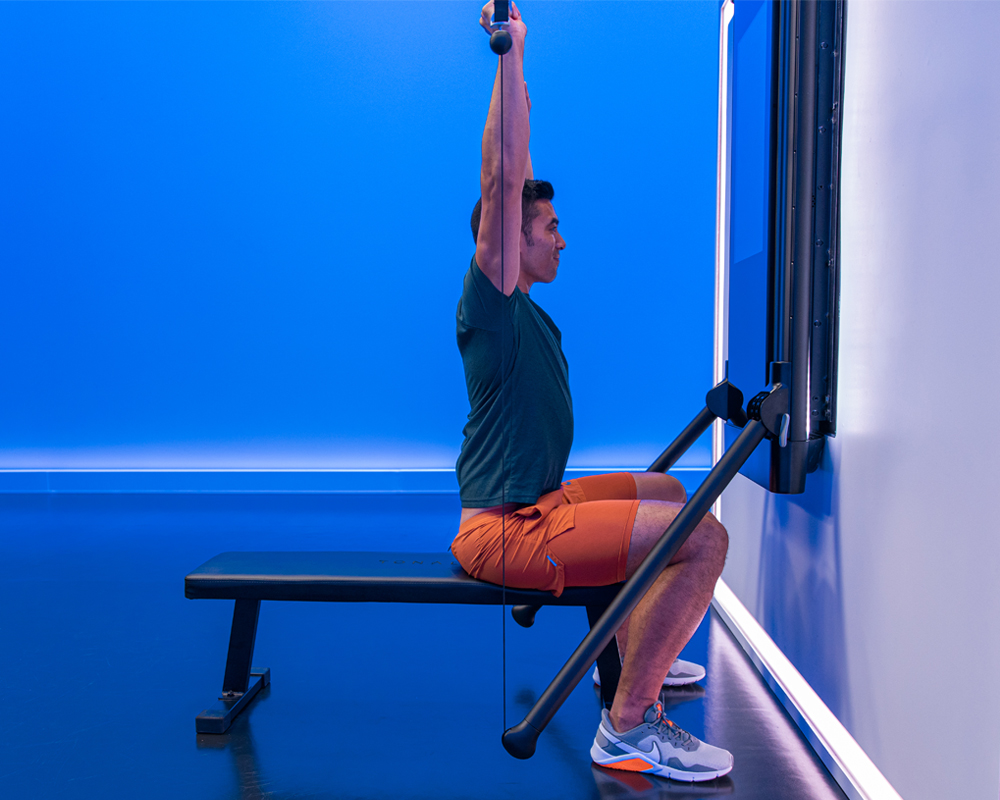
This muscle-building program is all about breaking through plateaus by utilizing cluster sets—or repeated sets of the same movement with very short breaks in between to spark new growth. The third workout of each week is dedicated to back and biceps work and features cluster sets of both the barbell seated lat pulldown and the barbell chinup.
Drop Set Strength – Coach Joe Rodonis
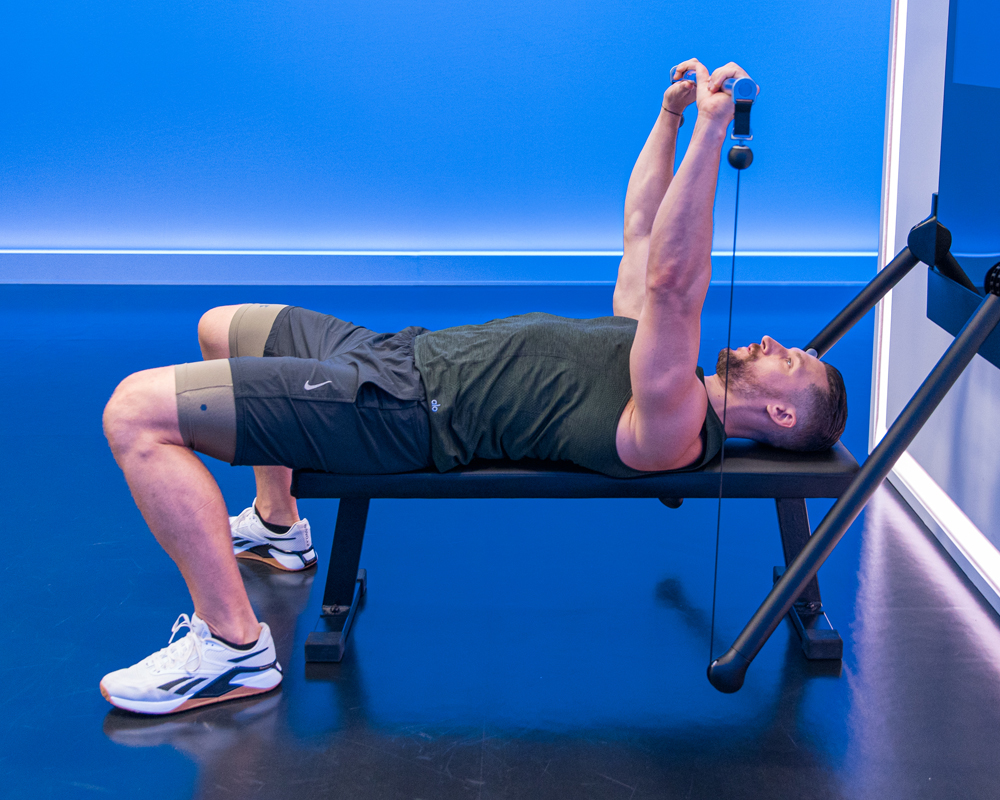
The workouts in this program aim to stimulate hypertrophy by using drop sets. As you approach failure in these sets, Burnout mode will kick in so you can keep repping out and accumulating volume. “You’re going to get those benefits of hypertrophy in a time-efficient way,” says Moore. You’ll spend two days each week focusing on your upper body in this program, with one session emphasizing back exercises including the barbell lat pulldown and barbell chinup with Burnout mode.
